The economic and social benefits of



The economic and social benefits of






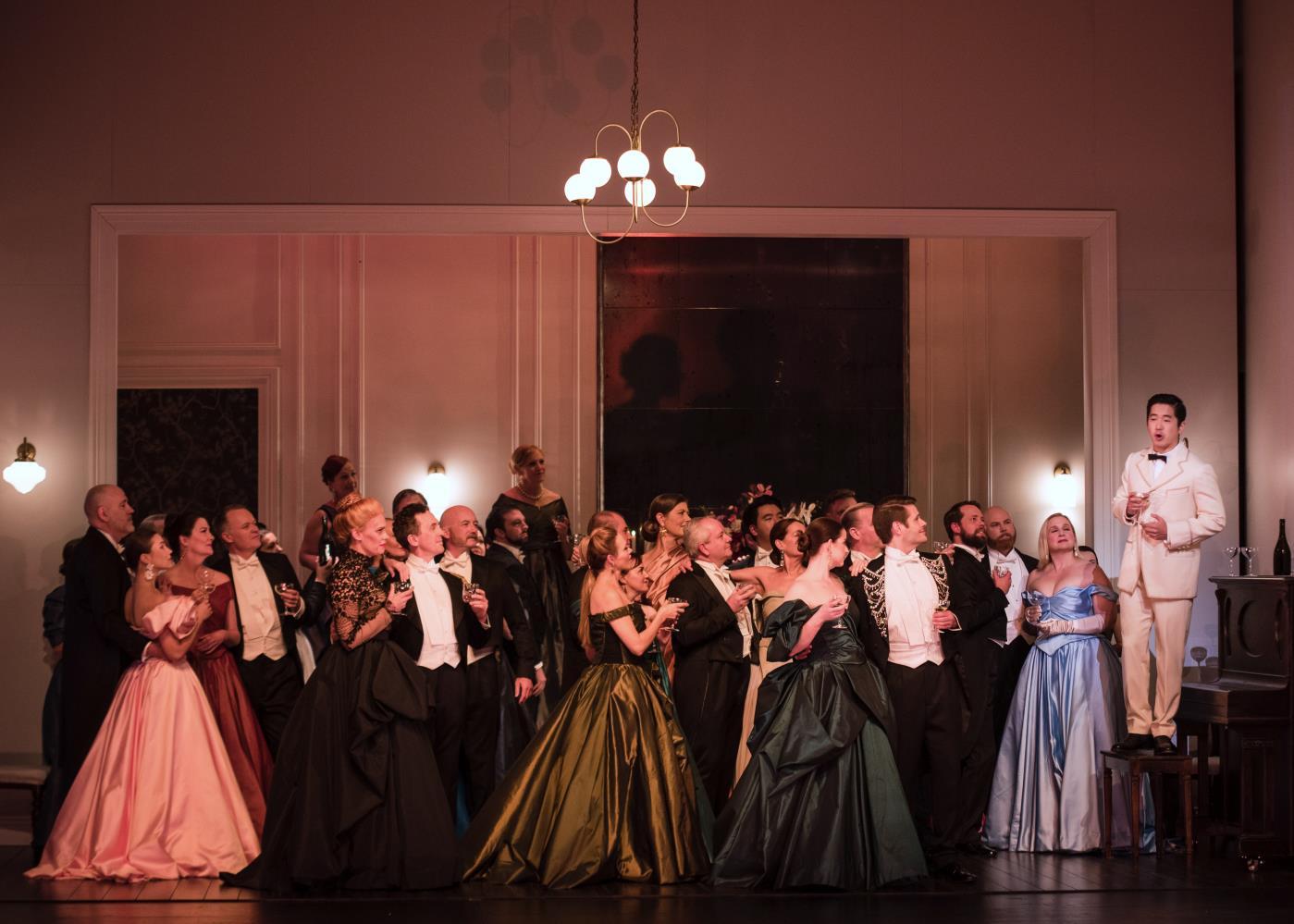
“Everythingwe do at Opera Queensland celebrates and interrogates the extraordinaryenergy that opera creates. One of our goals is to “Lead Change in Opera”. Key to this goal are our mainstage productions. On the mainstage we can explore the grand themes of life and reveal the extraordinary emotional possibilities of an artform that incorporates all the others - music played by a symphony orchestra, majestic storytelling, dance, stage, lighting, video design, fashion, and great singing.
In the productions we present, in our relationships with audiences across the state and artists across the world, in the works we commission and the way we work together as an organisation, we always seek to deepen our understandingand facilitate the growth of the Artform.
 Patrick Nolan CEO and Artistic Director of Opera Queensland
Patrick Nolan CEO and Artistic Director of Opera Queensland
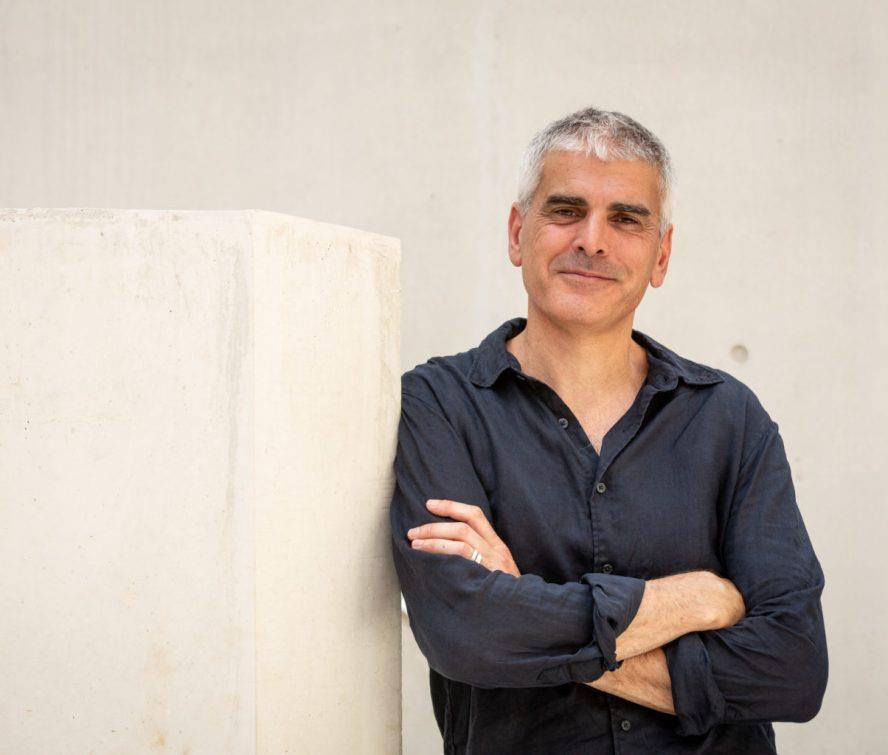
“As wemovefurtherinto the21st Century, thehopeis that opera in Australia continues to push boundaries and offerexperiences foraudiences to feelsomething deeperthan they’reused to. With a standing ovationand thewords written on thewall, it’s with all honesty that OQ have madeopera accessible, thrilling, and fearless.”
“Kaylee Randall, The Creative Issue“A minimum of three shows arerequired foran artistic directorto havea conversation with the community…Two shows arenota sustainablepresence;it is fleeting and intermittent.”
 Neal Harvey Tim Fairfax FamilyFoundation
Neal Harvey Tim Fairfax FamilyFoundation
“I justlove themelodic characteristics of opera. I don’tcareabouttheplots, I love themusic and how it comes together, themelodic value. It’s entirely irrationaland emotionaland I’m happy with that.”
PeterCoaldrake QueenslandPerformingArts Centre“I haverarely heard an audienceso unanimously thrilled by something innovative in an opera performance. This is a wonderfulexperienceof theatre.“
Nicholas Routley, The AustralianStage“Art in a way is the only thing thatreally separates us from theanimalworld. We need to elevate ourselves to be betterhumans. With opera, if we only do it twice a year, we will neverget to thefamiliarity thatdrives numbers up. Three is the minimum. Fivereally, butlet’s startwith three. We need the time to exposetheaudienceto something amazing butnotyetfamiliar”
Umberto Clerici QueenslandSymphonyOrchestra“Opera Queensland is a hugepartof Queensland’s culturallandscape… If anyonewants theexperience, weare reliant on Opera Queensland.”
Roxanne Hopkins QueenslandPerformingArts Centre
Opera is widely regardedas one of the highest forms of art, a classical medium that reachesto the limits of the human voice and moves listeners toa rapturous appreciation, asif, toquote Ann Patchett’sBelCanto, “life, true life, is something that is stored in music.”
But while many might recognise opera as an important social institution, it is often regardedas a non-economic activitywith limited benefits to the wider community.
This report challengesthat perspective. Through a rigorous research process, it examinesthe economic contribution of opera in Queensland and provides a clearer articulationof the society-wide benefits.
This Deloitte Access Economics report has been commissioned by Opera Queensland, one of Australia’sfive major opera companies, as it contemplatesmaking permanent a third annual mainstage opera production in Brisbane.
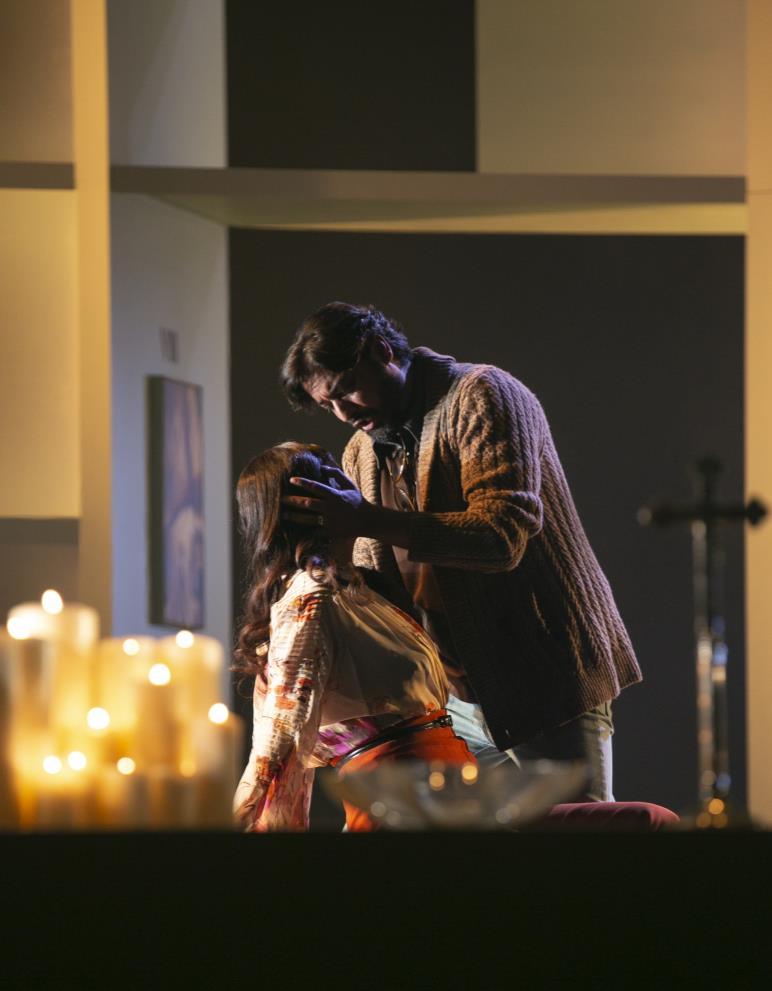

The report highlights the benefits of Opera Queensland and the impacts of a thirdmainstage on its artistic and commercialviability by considering:
• The benefits to opera audiences
• The benefits in terms of value added and employment
• The tourism benefits which arise from mainstage opera productions
• The contribution of opera tothe dynamism of Queensland’s broader artsand culturalsector
• The significance of opera asQueensland and South East Queensland embarkon a deliberate journey of transformation towardsthe Brisbane 2032 Olympic and Paralympic Games
• The social impactsof Opera Queensland on community connectedness and individual health and wellbeing.
The report has been conducted through a dual process of rigorous economic analysis including input output modelling. It has also involved a programof key stakeholder engagement including interviews withkey artsorganisations, the philanthropic sector and artsfunding agenciesin both the Queensland and Australian governments.
A detailedoverview of that methodology is provided in the appendix of this report.

Overall, the report presents three main findings:
1. That opera brings measurable economic benefits to audiences, the economy as a whole, employment and the tourism sector
2. That those economic benefits are amplified by social benefits including the strengthening of Queensland’s artssector andan improvement in wellbeing, and
3. That a stronger Opera brings potentialbenefits including broadening Queensland’s brand in the lead up to 2032
Opera Queensland productions are of significant economic value to audiences in Queensland and beyond. Those economic benefits can be measured in a number of ways: a consumer value perspective canshow how end-users benefits from Opera Queensland productions, while value added measures Opera Queensland’s contributions to the broader economy. Both approaches are used in this report.
In 2021, Opera Queensland created$1.7 million in consumer value—$1.4 million in ticket sale revenues, and an additional $0.3 million in ‘consumer surplus’. This reflectsthe value that consumers receive through the price of opera tickets, as well as the fact that, for many attendees, the value derived from their Opera Queensland visit is greater thanthe price of their ticket due to the unique experience of anopera performance.


The economic contribution of Opera Queensland in 2021 was $6.0 million in totalvalue added tothe economy. Opera Queensland supported 55 full time equivalent positions (FTEs), 18 of which were contributed indirectlythrough co-dependent organisations such as Queensland Ballet. Inheadcount terms, Opera Queensland supported 247 jobs. The revenue that makes up part of the consumer value also contributes to Opera Queensland’s economic activity, andas such the economic and consumer values are not additive.
In addition tothe value added is economic activitysupported by attributable tourismfrom intrastate, interstate andoverseas visitors which occurs throughthe mainstage productions of Opera Queensland. In total, $205,600 wascontributed in additional value added in 2021 through this tourism activity. Value added figures reflect the contribution of Opera Queensland to Gross State Product. Notably, this is smaller than the organisation’sexpenditure – a common result among entities that are publicly funded.
In future years, it is expected that the economic benefits supported by Opera Queensland would be even greater than2021 as the impacts of COVID-19 subside. The funding of a thirdmainstage production would enable Opera Queensland to capitalise on the returning interstate andinternationaldemand.
Opera, like other forms of artsand culture, produces a range of broader social benefits, including community pride, cultural understanding and improved mentalhealth. Opera has been found to be an inherently social activity, building strong relationship betweenaudience members and adding to community connectedness.
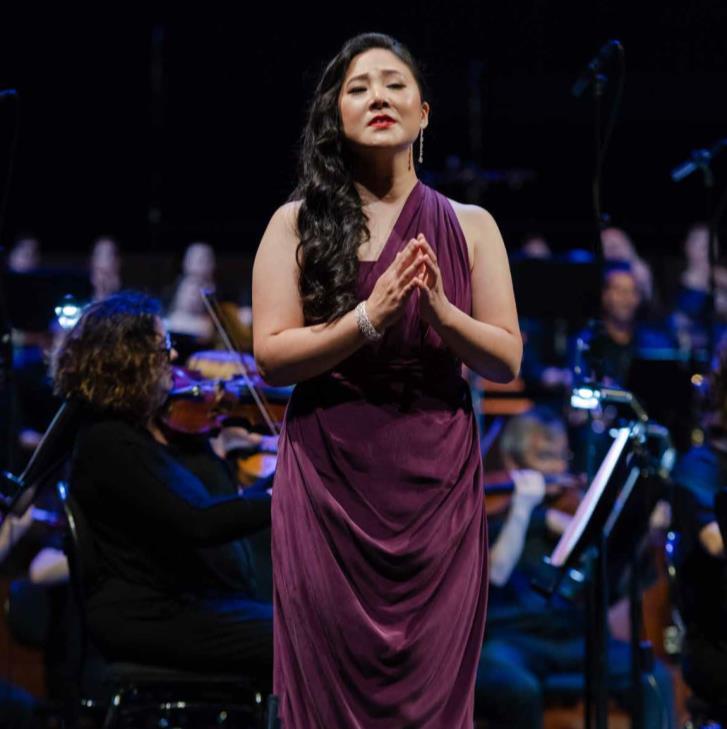

Opera Queensland is committedto building community engagement by connecting individuals through educational programs, providing singing workshops for children andadults, and by performing on tours travelling throughout regionalQueensland.
Opera Queensland’s performances provide opportunities for audiences to experience opera throughits arrayof accessible programs, contributing to the diverse portfolio of artforms available to Queenslanders and visitors. This, in turn, amplifies the broader artssector in Queensland and helps tobuild capabilities.
Further, Opera Queensland engageswith artistic companies, creative and non creative sectors which produces benefits for the broader arts industry and economy.
Opera Queensland also supports access to productions in regional and remote Queensland, such as the Festival of Outback Opera. In 2021, Opera Queensland hosted productions across 31 regionaland remote locations. Byproviding opportunity for donors and audiences to become more engagedwiththe company, a permanent third mainstage would also support a continued emphasis on regionaltouring.
With the Queensland Government committed tohosting the 2032 Olympics and Paralympic Games, timely investment into the opera would help to showcase Queensland as a culturalcentre in Australia. Infact, the Ipsos Life in Australia 2022 reportedthat Brisbane ranked second last relative to other Australiancapital cities in the category‘Museums, galleries& festivals’. This suggests there is anopportunity tostrengthenBrisbane's brand as a cultural destination and artistic centre.
$6.0 million in total value added through the economic contribution of Opera Queenslandin 2021.
$205,600 in total value added from tourismactivity attributable toOpera Queenslandin 2021.
31 regionalandrural locations reached through Opera Queensland’s tours in 2021.







the numberthatthe National Opera Review recommended Opera Queenslandhave.
5.5/10


Brisbane’s score in the Ipsos Life Australia report for the category ‘Museums, galleries & festivals’, only ahead of Hobart nationally.
178 employmentroles for artists andartworkers through mainstage productions in 2021.
$1.7 million total value to attendees from attending Opera Queensland productions in 2021.
$600,000 of additionalfunding requestedby Opera Queenslandto sustain a third mainstage production.
95% of attendees agree that ‘localresidents should feel proud’of the Festival of Outback regional production.

Opera Queensland was established in 1981 and is one of Queensland’s six major performing arts companies, along with the Queensland Ballet, the Queensland Theatre Company, the Queensland Symphony Orchestra, Circa and Dancenorth. Opera Queensland is one of five major opera companies in Australia.
Opera Queensland receives Queensland and Commonwealth government funding, alongside the revenue it generates from ticket sales, sponsorships, philanthropy and other donations. Between 2015 and 2019 inclusive, approximately ten thousand people a year attended opera productions by Opera Queensland, paying on average $88 for their experience, generating $6 million in cumulative revenue. Opera Queensland is known for its fresh interpretations of the canon and supporting world premieres of contemporary works. It also connects regional Queensland through signature events such as Festival of Outback Opera.
In 2016, the Australian Government undertook a National Opera Review (NOR), in response to financial and other pressures affecting all of Australia’s major opera companies. The NOR also noted that between 2009 and 2015, Opera Queensland had, on average, produced fewer mainstage productions than other major Australian opera companies, limiting the company’s capacity to build a core subscriber base and attract new audiences. The NOR recommended Opera Queensland and other state opera companies undertake a minimum of three mainstage productions each year, to ensure the financial and artistic sustainability of the companies.
In response, Arts Queensland provided Opera Queensland with a Tripartite Structural Adjustment and Temporary Funding Uplift from 2018-21, and a further once-off amount of $500,000 was offered as matched funding by the Australia Council to bolster the company's reserves. The additional funding supported three mainstage productions through 2021-22 (with 2020 being cancelled during to COVID-19). Opera Queensland is now seeking permanent funding to hold a third mainstage each year. A permanent third annual mainstage production will ensure Opera Queensland has the potential to meet a critical mass in terms of artistic vitality and engagement with performers, subscribers and potential audiences.
With no funding forthcoming, Opera Queensland will present a concert as its third mainstage in 2023.
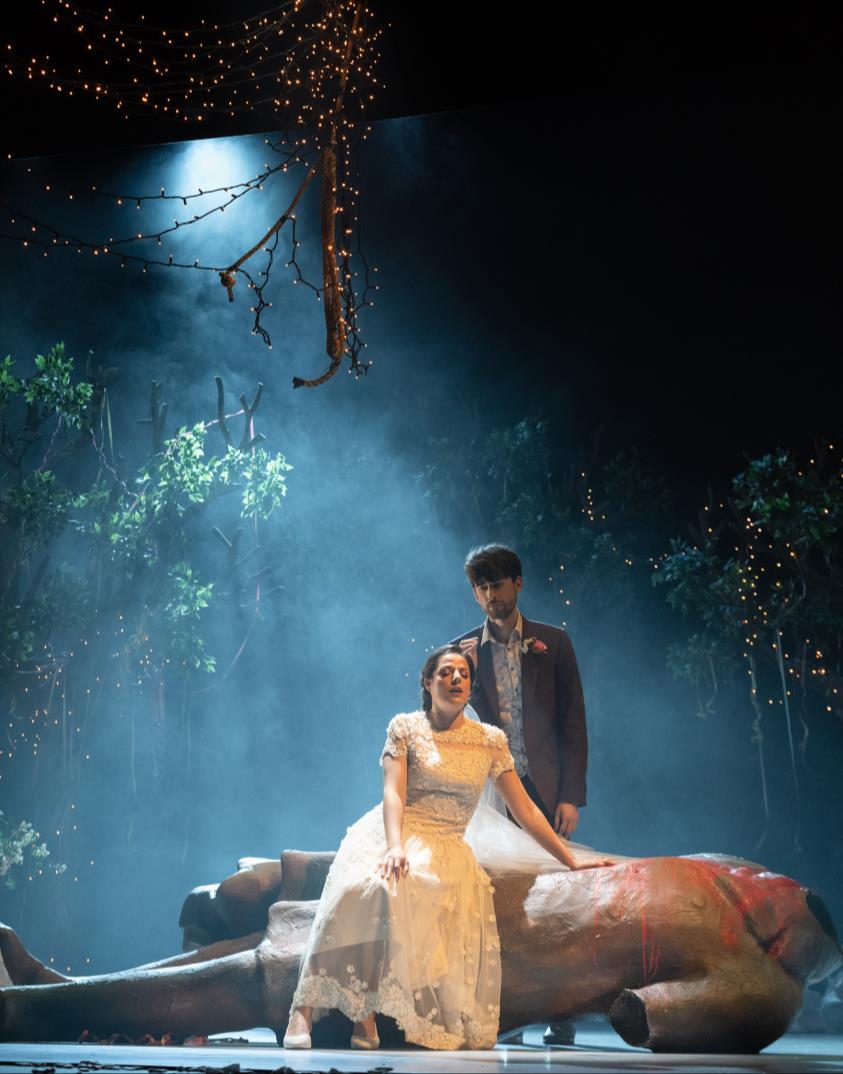
Opera Queenslandis inspiredtocreate an eventfor Brisbane and the State, whichwill make Brisbane an international destinationforlovers of great singing
In 2024 OperaQueensland is launching"Brisbane Bel Canto". This new festivaluses the rich and popular repertoire of Italian operas from the middle of the 19th Century as a springboard into acelebration of song in all its many forms. Brisbane Bel Canto will feature some of the world’s mostrenowned operasingers to presentaprogram of concert performances, surrounded by ahostof satelliteevents–recitals, masterclasses, pop-up performances –attractingaudiences from around Australiaand the world.
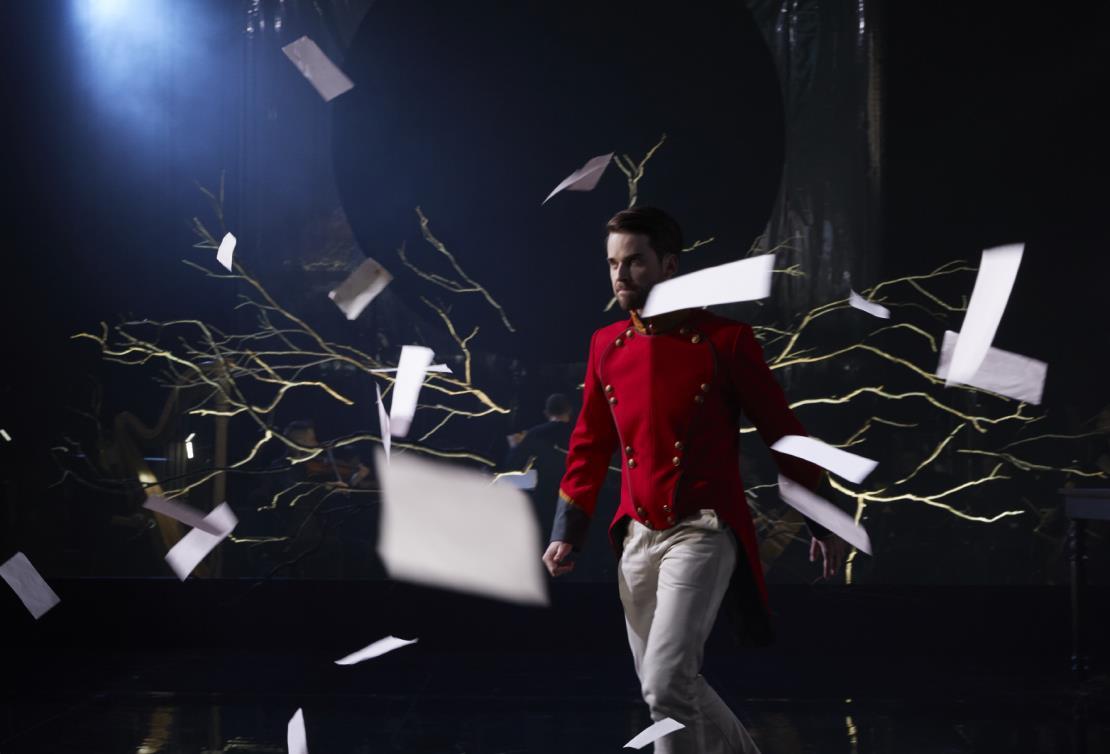
OperaQueensland ArtisticDirector, Patrick Nolan, willwork closely with Australia’s leadingBel Canto specialist, Toowoombaborn, internationally revered conductorand composer, Richard Mills.
Songand operaare part of Australia’s nationalnarrative:soprano Nellie Melbaappears on the $100 note and one of the world’s mosticonicbuildings is the Sydney OperaHouse. Australian Joan Sutherland is regarded as one of the greatestsingers in the history of opera, and as a country we have regularly produced singers who grace the stages of the world - several, (includingthe greatLisa Gasteen), fromQueensland.
“Brisbane Bel Canto”will be graced by some of the greatestsingers in the world in this repertoire- one of whom, JessicaPratt, grew up in Toowoomba. Jessicain the only Australian soprano, afterMelbaand Sutherland, to appearin both operaand concert at La Scala.
Singingis inclusive, itembraces all ages as shared activity. “Brisbane Bel Canto”willextend the reach of participation in songfarbeyond the performances of greatBel Canto titles like Luciadi Lammermoorand Barber of Seville. With the excellentfacilities of OperaQueensland as abase, there will be aspecially designed masterclasses foryoungsingers, concerts and recitals in Brisbane’s churches, and astate wide choircompetition the winners singingwith the stars of the festival.
“Brisbane bel Canto”will take its place in the international grid of OperaFestivals with links to the Rossini festival in Pesaro and the Donizetti festival in Bergamo (forwhich JessicaPrattis an official ambassador) and the Festival dellaValle d’Istriain aprocess of cultural exchange and co-operation. Future links will be established with Singapore, HongKongand mainland China. The festival will also build on the vibrant community of Italian heritage both in Brisbane and, in FarNorth Queensland.


Deloitte Access Economics has been asked to outline the economic and social benefits attributable to Opera Queensland in 2021, and to explore how a third mainstage contributes to the artistic and commercial viability of the organisation. A range of benefits are explored through this report, as outlined in Figure 1.
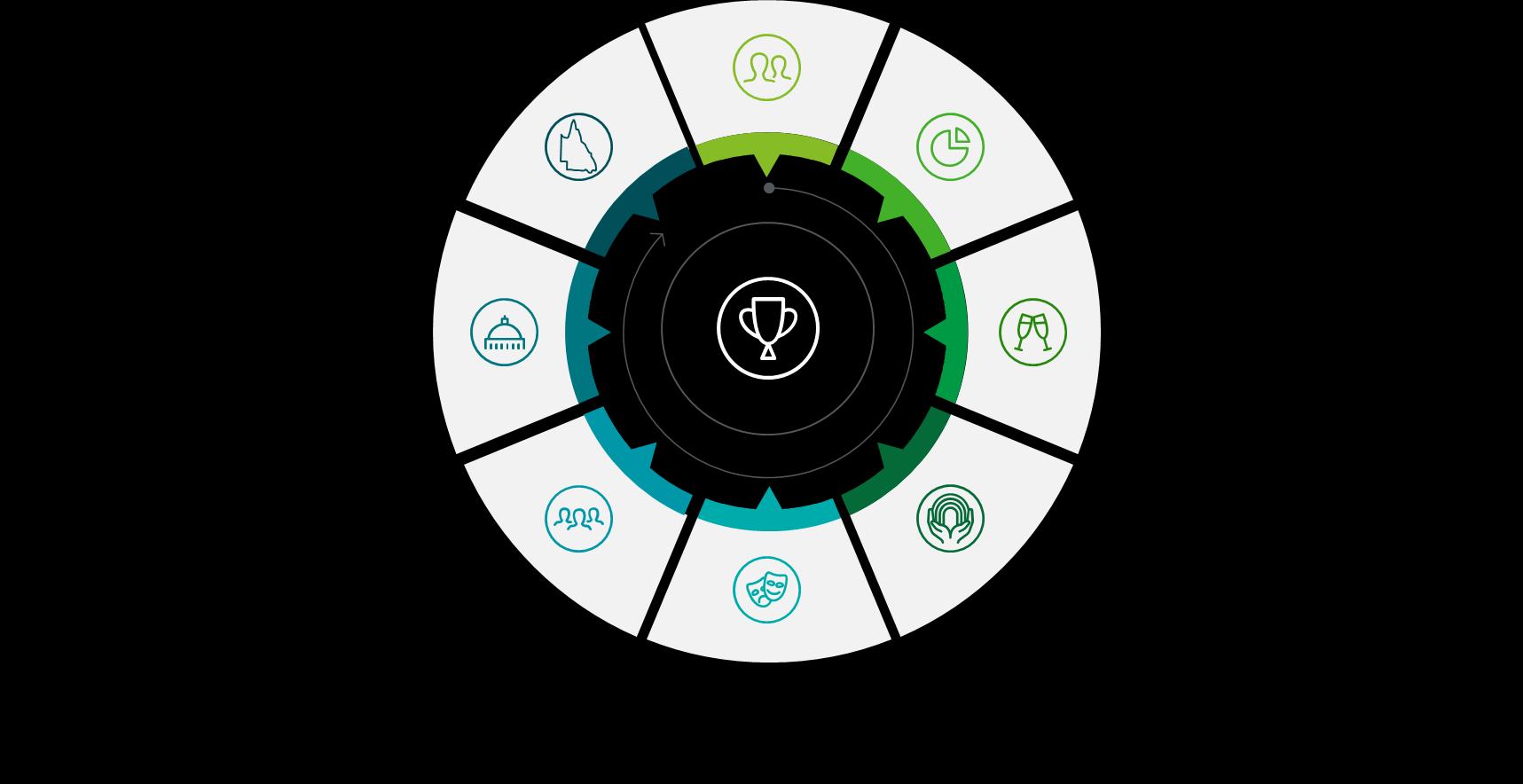
This report draws on numerous sources, including financial and audience data from Opera Queensland, Tourism Research Australia visitor survey data and State Tourism Satellite Accounts, as well as broader desktop research.
Additionally, to gain a more in-depth understanding of how Opera Queensland is placed in the Queensland arts scene, consultations were undertaken with representatives from Arts Queensland, Opera Queensland, Tim Fairfax Family Foundation, Tourism and Events Queensland, Queensland Performing Arts Centre, Australia Council and Queensland Symphony Orchestra.
The focus of this report is the economic and social benefits of Opera Queensland and importance of a third mainstage. It does not assess the costs associated with Opera Queensland’s activities, any risks or implementation issues, or consider this initiative against other alternatives. This study is based on a range of data provided by Opera Queensland, including forecast attendance levels, and this data has not been independently verified by Deloitte.
Opera is a unique, immersive artform bringing enjoyment and value to those who experience it. There are several ways of capturing the valueattendees gain from visiting the Opera. An appropriate starting pointis the market or transaction value.This is based on the priceattendees paid for a ticket, with the valueattendees gain from visiting the Opera at leastequivalentto the ticket price.In 2021, event income from Opera Queensland ticket sales was $1.4 million.*This includes attendances to not justthe mainstageperformance but other productions hosted by Opera Queensland.
Whilesubstantial, many consumers placea higher valueon the experience than the dollar valueof the ticket. The difference is commonly referred to as ‘consumer surplus’.The consumer surplus for opera is likely to be particularly significantbecauseof the uniquenature of the event. In addition, Opera Queensland’s prices arenot necessarily setata level to maximisereturns for the organisation.Hence, Opera Queensland’s ticket prices may understate the true valueto opera attendees.
In a relevantprevious study, Deloitte Access Economics undertook a consumer survey to understand how much more consumers would be willing to pay to attend productions atthe Sydney Opera House. Each participants’ responsewas then converted into a valuepremium (or consumer surplus) abovethe ticket price. The study found that consumer surplus is 37%of the ticket pricefor regular attendees and 14% for occasional attendees of the Sydney Opera. Applied to Opera Queensland, this suggests the consumer surplus to attendees in 2021 was equivalentto $247,000.
Whileimperfect, the valuepremium associated with attending the Sydney Opera House can be considered a reasonableproxy for the potential consumer surplus Opera Queensland attendees may derive given similarities in thenature of productions. Furthermore, whiledata on the frequency of Opera Queensland attendances is unavailable, information regarding thesubscription status of attendees in 2021 was used to informthe most appropriatevaluepremium to be applied.
Considering both the transaction valueand this consumer surplus, this suggests thetotal valueto attendees from attending Opera Queensland productions in 2021 was $1.7 million (seeTable1). Opera Queensland also offers performances which cater to aged careaudiences – ensuring that this consumer surplus is experienced more broadly by individuals who may otherwise be unableto access similar artforms.
*Note: The transactionvalue i.e.,the revenue from ticketsales also contributes to economicactivity whichis estimatedon slide 12. As such, the attendee value and economicvalue of Opera Queenslandare not additive.
Table
Component

Transactional value $1,416,000 Opera Queensland Financial Report(2021)
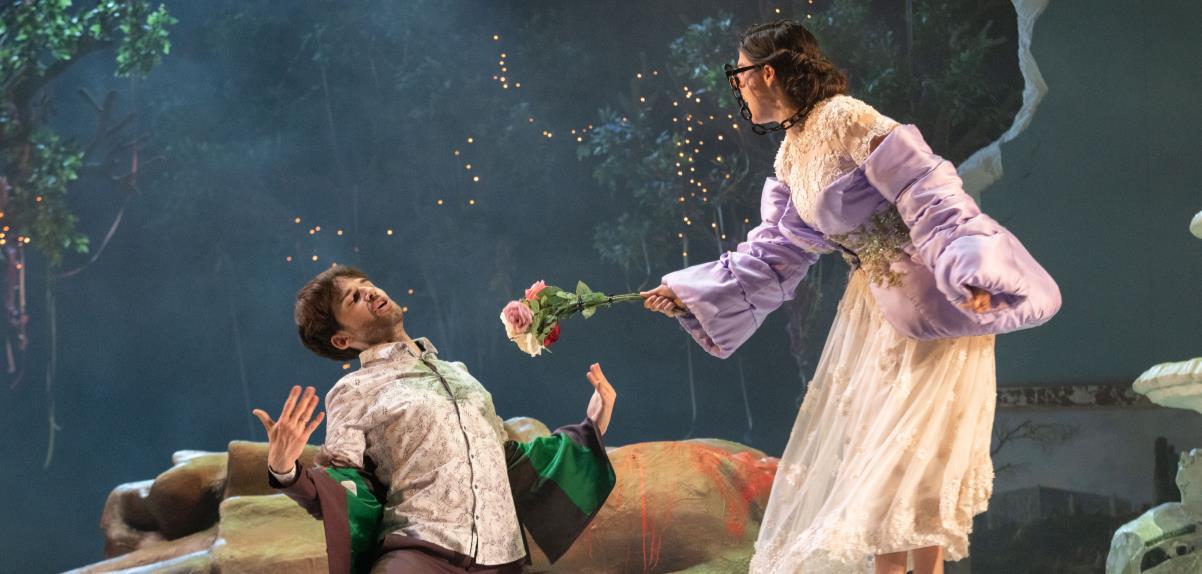
Weighted averagevaluepremium 17%
Derived based on ‘Revaluing Our Icon’ a report by DeloitteAccess Economics (2018) and the proportion of subscribers attending Opera Queensland’s productions.
Estimated consumer surplus $247,000 Calculation based on rows (1) and (2)
Total attendee value $1,663,000 Sum of rows (1) and (3)
Source: Deloitte Access Economics with othersources as noted in the table, 2021.
In 2021, opera audiences paid $1.4 million in ticket sales, but received a benefit of $1.7 million
On average, from 2015-19 (i.e., In contrastto the often perpetuated view that opera is a nicheartform patronised almostexclusively by inner city elites, audiencedata shows that every year, individuals travel from overseas, intrastateand interstate to view Opera Queensland’s productions.In 2023, Opera Queensland expects to welcome as many as 4,900 and 8,000 attendees to its firstand second mainstages, respectively, and 2,400 attendees for the Brisbaneconcertreplacing a fully funded third mainstage.
Pre-COVID, 73% of visitors were from Brisbane, 23% from other parts of Queensland, 4% from interstate and less than 1% from overseas.Figure 2 depicts the postcodes of attendees to Opera Queensland productions fromwithin Australia (from2015-19). Itdemonstrates that whileattendees aremainly concentrated in Brisbane, there area significantnumber of attendees from regional and remote areas, particularly fromNorth West Queensland (see Figure 2).
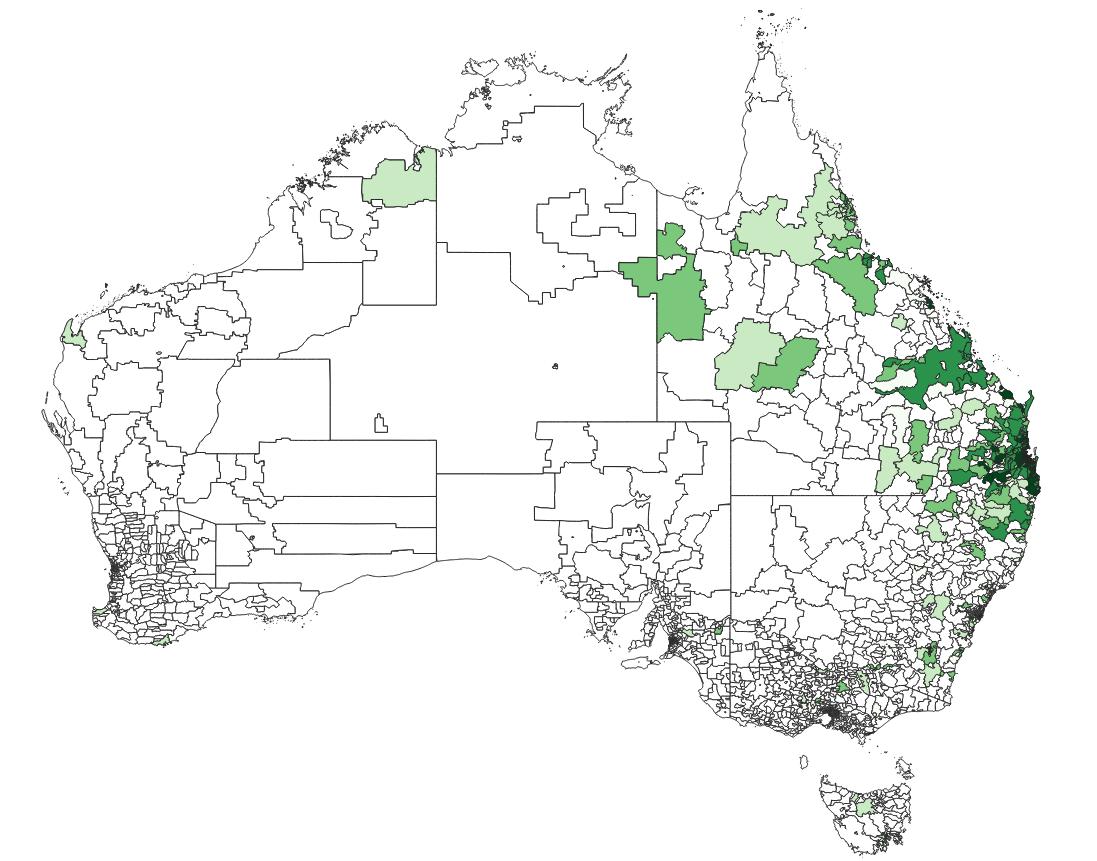
This report focuses primarily on quantifying thebenefits of Opera Queensland in the 2021 calendar year. Despite the cancellation of Aida production atthe Lyric Theatre and a largetelevised event due to COVID19, audiencereach was 149,645 in 2021. This include10,731 attendances to Opera Queensland’s mainstageproductions.Opera Queensland also reached closeto 17,500 regional and remote audiences.1
Moving forward, Opera Queensland expects to welcome an even greater number of attendees in particular to its third mainstageproduction. From 2023 Opera Queensland is planning to use the third mainstageto launch a new festival called "BrisbaneBel Canto“, targeting at attracting a largeshareof interstate and international visitors in particular.
A third mainstagewill becritical to Opera Queensland building its subscriber baseand audience engagement moving forward, in particular given the damaging impacts of COVID-19 over the pastfew years on the arts sector. COVID-19 prevented Opera Queensland from running any productions in 2020, and faced subdued demand in 2021 and 2022. The arts and recreation services industry, in fact, experienced a decrease in EBITDA of $649 million in 2019-2020.2
Source: Deloitte AccessEconomics
Note: Darker colours denote postcodes with a larger number of attendees.

The Opera Queensland audience comes from Brisbane, the rest of Queensland,interstateand
Economic contribution studies providea snapshotof the contribution of a company or industry, or in this caseOpera Queensland, to the economy at a pointin time. Notably, because revenue also contributes to attendee value, these results arenot additivewith transaction values estimated on previous slides. The headlinecontribution metrics indicate:
Direct value added
The direct valueadded demonstrates the returns generated from the direct labour inputs of Opera Queensland.Typically, this would also includegross operating surplus;however, due to the role of government funding in Opera Queensland, this is treated as a transfer rather than a net addition to the Australian economy.
Indirect value added
The indirectsupply chain effects from the demand for goods and services generated in other sectors as a resultof economic activity associated with Opera Queensland.
Results for 2021
• Opera Queensland contributed $3.9 million in directvalueadded, as well as $2.1 million in indirectvalueadded through upstream industries
• The sector also directly employed 37 FTEs whilesupporting an additional 18 FTEs indirectly through employment in codependent organisations such as Queensland Ballet, Queensland Symphony Orchestra, Queensland Theatre, Circa and Dancenorth
• In headcount terms, Opera Queensland reported supporting the employment of 247 people.
The economic contribution of Opera Queensland
In 2021, Opera Queensland’s activities contributed a total of $6.0 million in valueadded, with $3.9 million contributed directly and $2.0 million contributed indirectly through induced demand in upstream industries (seeChart1).
Opera Queensland contributed 55 FTE jobs;37 FTE jobs directly and a further 18 FTE jobs indirectly (seeChart2).
The indirectvalueadded of Opera Queensland totalled an additional $2.1 million in valueadded and 18 FTE. Many of these benefits are reaped by the broader Queensland arts sector.

The economic contribution modelling for Opera Queensland was undertaken using the Deloitte Access Economics Regional InputOutput Model. Estimates arebased upon expenditure and employment expense figures availablein Opera Queensland’s 2021 financial statements, and these were supplemented with data provided by Opera Queensland on total employment and mainstage productions.
Notably, expenditure totalled $7.3 million in 2021 –less than the $6.0 million in total valueadded due to the treatment of government funding as a transfer rather than a net addition to the Australian economy. This is a common finding among entities that are publicly funded. Further details on the economic contribution approach can be found in the Appendix.
Source: Opera Queensland, DAE-RIOM, Deloitte Access Economics
In 2021, Opera Queensland contributed $6.0 million in total valueadded to the Queensland economy and supported 55 full-time equivalentjobs
In addition to the broad array of social and economic benefits described throughout this report, Opera Queensland also attracts intrastate, interstate and international tourismto Queensland.The tourism spend of visitors attributableto Opera Queensland in 2021 is driven by three key elements:
• attendance by placeof origin;
• average visitor expenditure; and
• the attribution of visitation to Opera Queensland productions.
Attendance to Opera Queensland productions was assumed to be limited to 2021 mainstageproductions, excluding smaller productions and regional productions. Using this method, Opera Queensland attracted 6,411 (72%) Brisbanevisitors, 2,281 (26%) intrastatevisitors, 226 (2%) interstate visitors and eight international visitors (seeChart 3).
To estimate average visitor expenditure, this information was supplemented with data on the average spend of visitors to Brisbanewho primarily visited to attend theatre, concerts or other performing arts for a holiday in 2021.The analysis assumes half of a day of tourismexpenditure can be attributed to all mainstageproduction attendees a conservativeassumption given the average stay of holidaying visitors in 2021 was 2.2 days. This attribution also reflects an approach utilised in previous studies.3
$215 per intrastateopera visitor to Brisbane
Chart 3: Attendance by place of origin
Interstate
2% International
Intrastate 26%
0% 9,012 attendees
Brisbane
72%
Attributed opera visitor activityii
$189 per interstate opera visitor to Brisbane
$99 per international opera visitor to Brisbane
Expenditure per visitor estimates were derived using TourismResearch Australia Visitor survey data for 2021. In total, itwas estimated that tourismattributableto Opera Queensland totalled $269,000 expenditure, with $247,100 deriving from intrastatevisitors, $21,600 frominterstate visitors and $400 from international visitors. Notably, attributableexpenditureby international visitors tends to be lower than intrastateand interstate expenditure becausethey stay for longer periods of time, meaning their expenditure is apportioned over a longer period of time.
$247,100
Intrastatevisitor attributed tourismspend
$21,600

Interstate visitor attributed tourismspend
$400 International visitor attributed tourismspend
i. Note that 86visitors were missing theirplace of origin in the provideddata; for modelling purposes, their place of origin was allocated according to the distribution of places of origin of the available data.
Source: Opera Queensland; Tourism Research Australia;Deloitte Access Economics
Note: (ii) Using Tourism Research Australia visitor survey data ‘opera visitors’ are definedas those who visited Brisbane to attend theatre, concerts or other performing arts with ‘holiday’as the main purpose of visit.
As a major contributor to the Queensland arts ecosystem, Opera Queensland’s productionsattract the expenditure of intrastate,interstateand international visitorsto the state
Opera Queensland productions attractinterstate and international visitors to Queensland, as well as intrastateregional visitors who travel to Brisbanefor the productions as an alternativeto travelling interstate or overseas (and thus their spend is retained within their state economy). This analysis captures the economic contribution of the tourismexpenditure associated with visitors who make a trip to Brisbaneor allocatea portion of their stay in Brisbanein order to attend an Opera Queensland production.This attributabletourismresults in economic benefits to the Queensland economy as these visitors spend money on accommodation, touristattractions, food and beverages, transportand other activities.
With an underpinning of the attributablevisitor expenditure, this analysis demonstrates the tourism contribution of Opera Queensland in terms of valueadded and full-timeequivalent(FTE) employment for the Queensland economy. This contribution is broken down into direct and indirectcomponents:
• Direct contribution is the valueadded and employment generated by producers and retailers that directly interactwith visitors who aredrawn to Queensland to attend performances by Opera Queensland.
• Indirect contribution is the valueadded and employment in the wider economy created by the chain of suppliers to the direct providers of services. For example, the valueadded created by food manufacturers who supply restaurants. Therefore, the figures presented in this analysis areadditivewith the figures provided in the economic contribution analysis.
This study drew on information from a range of sources including Opera Queensland ticketsales data, TourismResearch Australia visitor survey data and State TourismSatelliteAccounts. The method through which this data estimated tourismactivity attributableto Opera Queensland is outlined on the previous page.
The analysis uses a TourismSatelliteAccount (TSA) framework to measure the economic contribution of attributabletourismspend. The TSA framework is conceptually similarto and draws on the principles underlying the Australian National Accounting Framework (which underpins traditional input-output contribution modelling), but accounts for the unique characteristics of the tourismindustry.
Further details on the data and modelling approach can be found in the Appendix.

The attributabletourismassociated with Opera Queensland contributed a total of $205,600 in value added to the Queensland economy (see Table2). Of this, $97,500 in valueadded was contributed directly through tourism-based activities such as accommodation, touristattractions, food and beverages, transportand other activities, while$108,100 was estimated to be contributed indirectly through upstream industry activity, such as food and beverage manufacturing.
Notably, whileestimated direct benefits will primarily beallocated towards the Brisbaneeconomy, the indirectbenefits are anticipated to benefit the broader Queensland economy.
Direct Indirect Total Value added ($) $97,500 $108,100 $205,600
Source: Deloitte Access Economics
The tourismbenefits estimated for 2021 arenot representative of a normal year due to the subdued tourismdue to the COVID-19 pandemic. In 2019, the mainstageproductions fromOpera Queensland were attended by 9,670 people, compared to 2021 where there were 9,012 attendances. This is despitea third mainstageproduction occurring in 2021 and not in 2019.
By comparison, Opera Queensland anticipates itwill attracta total attendanceof over 13,000 in 2023 with the running of a cut-cost third mainstage. There is scopefor this attendance level to increasefurther in 2023 with the provision of an additional $600,000 in Opera Queensland’s annual budget. This would not only increaseattendance levels by enabling an annual third mainstageproduction;itwould also support the launch of the BrisbaneBel Canto festival to further attract audiences fromaround Australia and Asia.
The arts and culture sector in Queensland, of which Opera Queensland is a corecontributor, forms an integral partof the state’s social and cultural identity, with material impacts on a number of aspects of Queensland society.Adding a third mainstageproduction will help amplify thevarious social and cultural benefits attributed to Opera Queensland as outlined below.

Community pride and involvement
Opera Queensland provides social and cultural benefits to the state by contributing to the variety of artforms Queenslanders can access and adding to their overall wellbeing.Such benefits are not only experienced in metropolitan Queensland, but also regionally, as Opera Queensland is committed to deepening engagement with regional and remote communities.
Engagement with or involvement in the arts has been suggested to have positiveimpacts on communities, individuals’ senseof belonging and social interactions.The 2020 National Arts Participation Survey found that Australians areincreasingly acknowledging theimportance of the arts and its positive impactin communities. In fact, the survey found that 53% of Australians agreed that the arts allow them to connect with others and 60% affirmed that the arts help with understanding other people and cultures.4
60% of Australians agreedthat the arts help with understanding other people and cultures.
Importantly, the opera is perceived to be an inherently social activity;building strong connections between attendees. Indeed, operagoers have been found to highly valuethe presence of other people at productions.5 Attendees of the performances often consider factors such as other spectators’ responses to the performance and with whom they attended the event with respect to their experience.6
In 2021,Opera Queensland extended audience reach into 31 regional and remote locations as part of its regional productions. 7 The positiveimplications of opera on the community were also found in feedback surveys conducted by Opera Queensland.For example, 92% and 95% of attendees, respectively, agree that ‘local residents should feel proud’ of the Sopranos and Festival of Outback Opera regional productions.
95% of attendees agree ‘local residents should feel proud’ of the Festival of Outback regional production.
In addition to regional tours, Opera Queensland engages and improves the connectivity of the community as partof its 2021-22 strategy. The initiatives includes programs such as workshops with schools in remote FirstNations communities, providing community singing events to encourage continued learning and supporting people with disabilities to engage with the opera.
A third mainstageproduction contributes to Opera Queensland’s broader functions, allowing them to undertake the regional touring programand continue contributing to communities around the state. The tours and strategic initiatives havewideranging benefits, from building community prideand connectedness, as discussed, and wellbeing benefits to attendees, highlighted below.
The arts make a measurable contribution to wellbeing and overall health
Engagement with creativecultural activities, such as theopera, has also been found to have a positive impacton wellbeing and overall health.
Specifically, engagement in the arts has been linked to increased satisfaction with quality of lifeand feelings of happiness.8 Additionally, participation in receptiveand creativecultural activities has been significantly associated with good health, lowanxiety and depression.9 These notions were also explored in the 2020 National Arts Participation Survey which found that most Australians agreed that arts and creativity havea significantimpacton their senseof wellbeing, happiness and ability to deal with stress, anxiety and depression.
Exposure to the arts has also been linked with positivehealth outcomes in relation to the social determinants of health. For example, engagements with arts and culturehelps generate a larger, more diversesocial network, leading to social capital and improving overall health outcomes.10
Improving the health and wellbeing of all Queenslanders and reducing health inequities is oneof the priorities of Queensland’s statutory agency Health and Wellbeing Queensland.Providing opportunities for Queenslanders to experience and engage with a range of artforms, such as the productions executed by Opera Queensland, supports the goals of Health and Wellbeing Queensland. This sentiment was also highlighted by Neal Harvey from Tim Fairfax Family Foundation, stating that“Opera Queensland is delivering on these outcomes for the government”, with regards to Health and Wellbeing
Queensland’s goals.
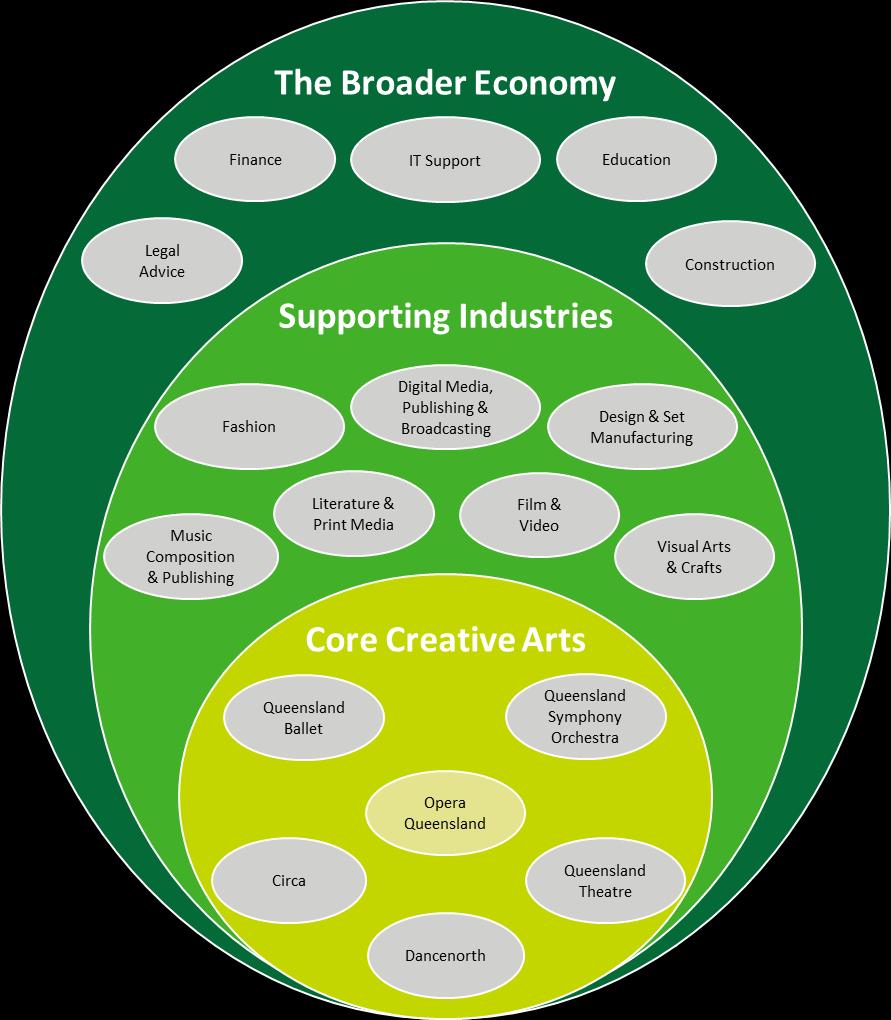
Opera underpins other activity across the sector
Opera is a unique artform, combining singing, acting, dancing and music. Itcan be traced back to the early 17th century, with the oldest surviving opera, Euridice, having been created in 1600.11
Opera is widely regarded as a keystone artform, with the existence of at leastone healthy and vibrant opera company serving as a foundation both for the broader sophistication of the public cultural landscapeand for the viability of related arts companies and artists. As illustrated in Figure3, Opera Queensland, and the core artisticcompanies in Queensland, supporta rangeof creativeindustries in Queensland such as fashion, musiccomposition, digital media, design, visual arts and crafts, literature, printmedia and publishing.
The important roleof Opera was recognised through the consultation phaseof this projectwith Queensland Symphony Orchestra Chair, Rod Pilbeamrecounting that when Boeing sought to establish an Australian presencein the 1990s, the existence of opera was considered a critical factor in choosing a home city because he said Boeing took the view that “the senior people who would settle down there would be looking for activities such as opera.”
Queensland Symphony Orchestra’s Yarmila Alfonzetti explained the criticality of Opera Queensland to the company, not justbecause its musicians areemployed providing pitservices for opera but because of the criticality of opera’s musical canon;“The opera repertoire is a vital part of the canon we need our musicians to play, and that they want to play.”
Rod Pilbeamalso emphasized this sentiment, when he stated:
“Opera productions create a diversity in the music product that’s being pushed into the market … If we didn’t have an opera company, we would have to do some concerts to keep that repertoire because it’s great repertoire. The opera company exposes that repertoire and that broadens our overall audience”

Opera Queensland is a key party of the sophisticated arts offering and often collaborates with other arts companies, ultimately contributing to and uplifting the arts sector as a whole. In fact, in 2021, Opera Queensland collaborated 14 times with other art companies.12
Opera is a critical part of the Queensland Performing Arts Centre’s artistic offering
Roxanne Hopkins from Queensland Performing Arts Centre reinforced the sentiment that Opera Queensland provides a uniqueexperience for audiences which would only be found interstate if not for the Company. “If anyone wants the experience, we are reliant on Opera Queensland.”. She also noted the importance of the breadth of art that Opera Queensland contributes, “For the arts to make impact in the community, it has to be wide ranging.”
Opera Queensland is a keystone for a sophisticated and vibrantQueensland arts sector
Opera Queensland supports professional and aspiring artists and arts workers across a rangeof specialisations including composers, singers, conductors, musicians, writers, directors, designers, production and technical specialists.
Opera Queensland is a significant trainer and employer of high quality artists and arts workers
As the most complex and sophisticated of the performing arts, Opera Queensland trains a rangeof arts workers across multipledisciplines to a very high level of competence. In 2021, Opera Queensland employed 37 FTE employees.13 Opera Queensland also provided 178 employment roles for artists and art workers and spent $959,000 in wages across mainstageproductions.Key data shows that prior to the pandemic, Opera Queensland employed approximately 90 artists and arts workers and spent on average $470,000 on salaries and wages on each mainstage production.
Opera Queensland creates a pathway for young artists and arts workers
Opera Queensland maintains a strategic focus on career development of young and emerging artists.The company provides opportunities for students through programs such as the Young ArtistProgram and by partnering with Queensland ConservatoriumGriffith University and University of Queensland School of Music.A third mainstageproduction supports Opera Queensland in its broader functions, such as supporting young artists.In factOpera Queensland employed 10 emerging artists and provided opportunities for four artists to move through training programs to mainstageroles in 2021.14
The importance of providing opportunities for young people was also supported by Anne Cross from Opera Queensland, who stated:
“Continuity of employment for young people is a big social problem for us as a country. There are so many roles in the arts. If, as a state, we aren’t able to provide that employment people will go to other sectors or interstate.”
Opera Queensland is a critical player in reinvigorating the arts sector after COVID
The impactof COVID on the arts sector is well known. Within fivedays after the declaration of the pandemic, 190,000 people were impacted by cancelled work opportunities.15
Opera Queensland’s (postCOVID) Strategic Recovery Plan 2020-21 places a high priority on rebuilding the arts workforce including by reigniting the Young Artist Programand by creating diversepracticeby working with established artists fromoutsideopera.
As an established company requiring a rangeof critical skills, Opera Queensland and the possibility of a third mainstageprovide an important platformto rebuild the arts skills baseas postCOVID recovery builds.
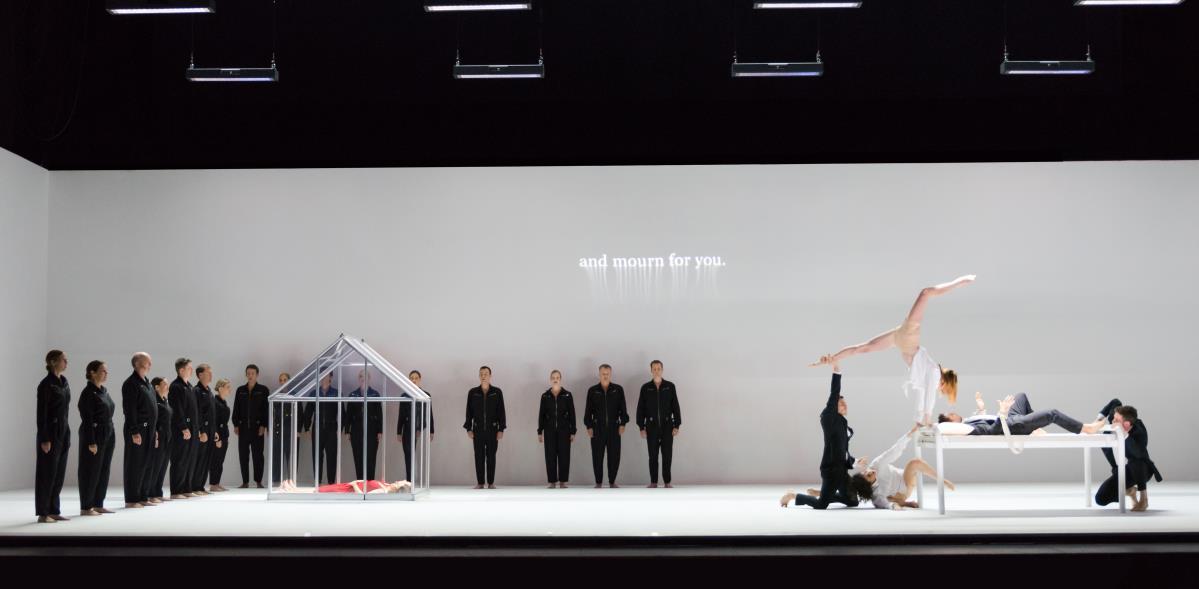


Sarah Holland-Batt is an award-winningAustralian writerand a Professorof Creative WritingatQueensland University of Technology (QUT). She is the authorof three books of poems (Aria, The Hazards and The Jaguar), and a book of essays, FishingforLightning. In 2016, she was awarded the Prime Minister’s Literary Award for Poetry.
Sarah started on her careerpath as a poetin university. She studied in New York, where she visited the MetOperamostweekends and gained exposure and interest in the artform. Her first book, Aria, also explores themes related to the opera.
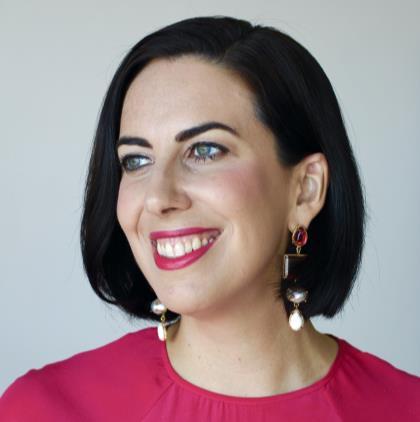
Last year, she was commissioned to write anew operafor the OperaQueensland mainstageseason. Throughoutaseries of conversations with the artistic directorof OperaQueensland Patrick Nolan, this evolved into ‘The Sopranos’. The operaexplores the bold and rebellious roles women have played throughout the history of opera. Sarah worked closely with Jane Sheldon duringthe writingprocess, acontemporary operaartistand dramaturg, as well as the conductor JessicaGethin, setdesignerMarg Horwell, costumedesigners Karen Cochetand BiancaBulley, and the OperaQueensland Chorus.
Sarah expressed how she found the process of writingan operachallenging, despite havingan established and celebrated careeras a writerand poet. Sarah describes how the writingstyle forperformingarts is vastly differentto thatof poetry, beingmore of a collaborativeandfluid process compared to poetry, where she had full control. However, Sarah found itto be a rewardinglearningexperience. Itallowed herto gain a network of people to work with in the future and would welcome the opportunity to write acompletely original work. Unlike in poetry wherewritingis the main focal point, in operathe writingis only one elementof the audience’s experience. Itis arich artform which consists of lights, music, sound, actors, and the set, meaningSarah had to make additional considerations forthe show structure, intermissions and musicalpieces within herwork. Importantly, the experience of writingan operataughthera personal life lesson. In herown words:
“As a poet, perfection is the aim. In a poem every single stanza is there to servea purpose. In a collaborativework thereare compromises …sometimes you have to givein, and thatis valuableto me as a personallife lesson noteverything has to bepursued in a way thatI imagined it.”
Overall, writingan operawas a transformative process forherpersonally and professionally.
Sarah is well-known in the Brisbaneartscene. However, this experienceallowed herwritingto be shared and appreciated in adifferentdomain and to a differentgroup of audiences. ‘The Sopranos’ also attracted mediaattention and academiccommentary. Importantly, itgotherexcited to work on operain the future, and she is currently in talks with a composeraboutan opera.

Marcus Corowa is an award winning, FirstNations artist. Marcus grew up in North Queensland playingthe guitarand decided topursue acareerin the performingarts atage 26. In 2012, Marcus won the ‘Most PromisingNew Talentin Music’ award at the Deadly Awards. He is an accomplished singer, songwriter, composer, actorand mentor.
Marcus draws on his Aboriginal and SeaIslanderheritage to create music. Before workingwith the classical elements of the opera, Marcus created musicin the contemporary space, blendingjazz, blues and funk elements.
Marcus firstexperienced workingin the operaticspace with OperaAustralia. He was then invited to collaboratewith OperaQueensland on anew show that explored where the genres of operaand country musiccrossover. Marcus developed and grew as an artist while workingwith OperaQueensland. Enteringthe space with limited experience in the classical art, Marcus undertook lessons provided by OperaQueensland to develop his skills in Italian. Learningon the job, Marcus noted how he was provided opportunities to grow, havingcontent“thrown”athimand beingpartof the creative developmentof artisticpieces. While Marcus did not have a formal background in opera, OperaQueensland saw potential in him. “They had a hunch thatI could be a cross overperson even though I’d neverexplored thataboutmyself. I grew to fill thatrole.”
Marcus has significantly contributed as an artistto OperaQueensland. He performed in the ‘Are you Lonesome Tonight’ tourin2021, visitingmore than 30 communities across Queensland. In Novemberof 2022, Marcus performed his recital ‘SomeKind of Wonderful’. In 2023 he will tourthe state again in ‘Lady Sings the Maroons’. Clearly the collaborations with OperaQueensland have had substantialimpacts on Marcus’ career, as Marcus notes:
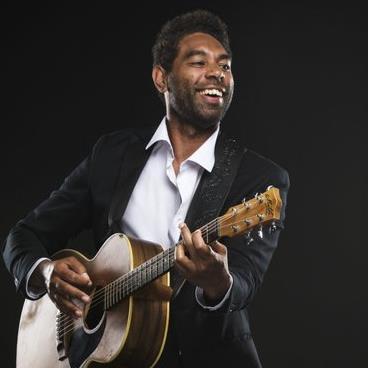
“As an artist, I’vebeen really enjoying working forthem. Just growing within myself and exploring my capacity forclassicaland opera music. I probably would havenevergonedown this road as much as I haveif it wasn’tforOpera Queensland. I havelearntso much from being in thatplace and space”.
In addition to his own artisticgrowth, Marcus expressed the significance of the uniqueopportunity he had throughoutthe creative process to provide an Indigenous lens to OperaQueensland’s performances. He noted thatthe work was “oneof the few opportunities” to bringan indigenous perspectiveto arts in Queensland. Remarkingthatwhilethe landscapeis changing, and inclusion of FirstNations’ voices is becomingmore prevalent, “it’s a raresituation to be in.
Furthermore, Marcus emphasises how workingwith OperaQueensland has had flow on impacts on his career, ‘bringing [him] back into thespotlight’. He is now involved in the developmentof anew work with OperaQueensland and has been invited to perform in the Lord Mayor's ChristmasCarols in Brisbane.
When asked if Marcus was livinghis dream, he replied“Absolutely …I never thoughtthatI would getto do half thethings I’vedone. I am enjoying thejourney, the growth and thechallengethateach projectand dooropens.”
The 2019-2021 Temporary Funding Upliftenabled Opera Queensland to return to presenting three mainstageproductions a year. Having consistentfunding for a third mainstageproduction would enable Opera Queensland to continue its leadership rolein programming emerging artists, commissioning new works and reimagining works fromthe canon. In addition, a permanent third mainstageproduction improves the artistic viability of the company.
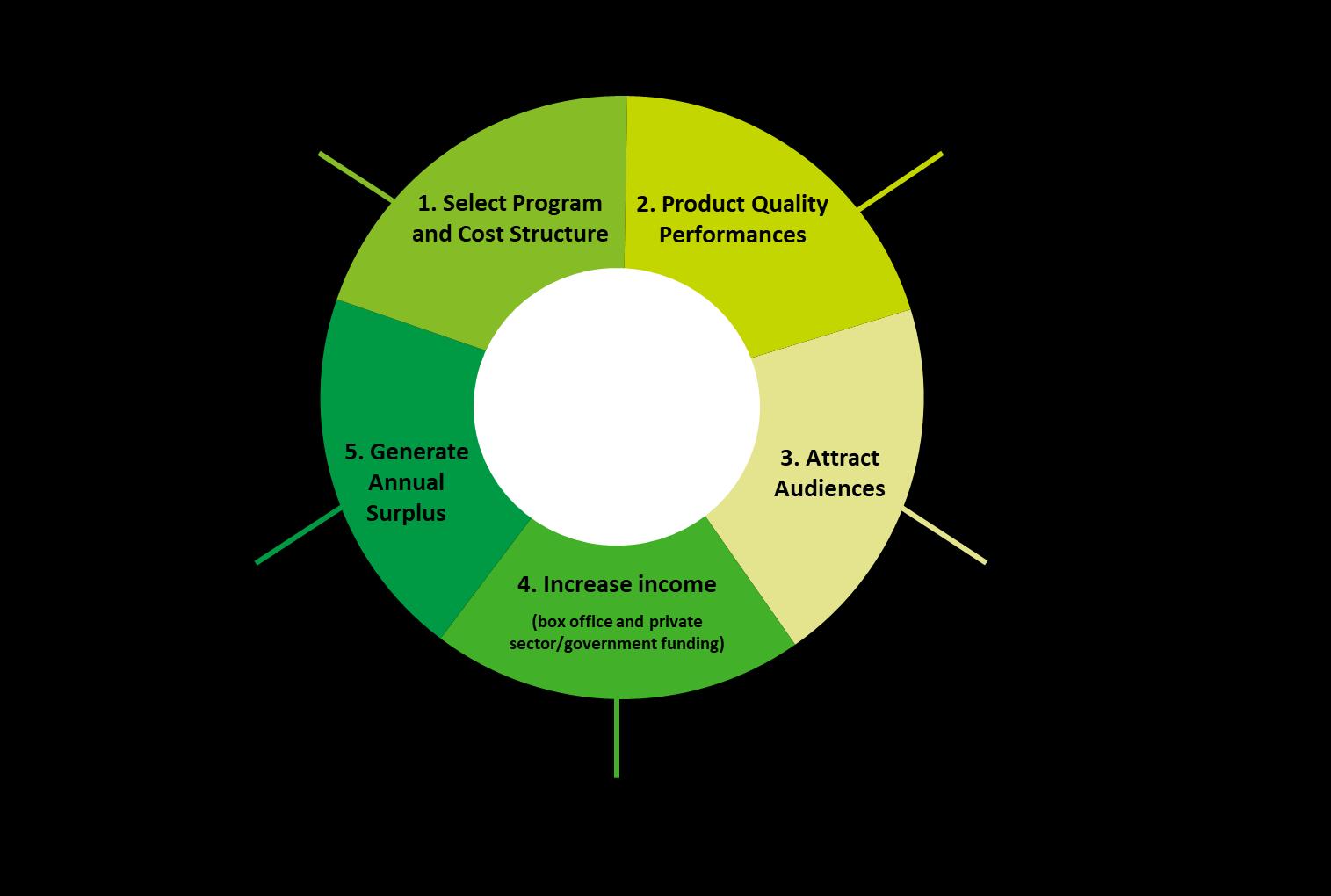

The proposed third mainstageproduction will enableOpera Queensland to become viableopera company and be comparableto other major Opera companies in Australia.For example, Opera Victoria and Western Australia Opera hostatleastthree mainstageproductions annually.
Three mainstageproductions annually also means audiences can engagewith Opera Queensland consistently throughout the year; improving the valueproposition for subscribers.Neal Harvey, from Tim Fairfax Family Foundation echoed the necessity of a permanent third mainstageproduction for audience engagement and development:
“A minimum of three shows are required for an artistic director to have a conversation with the community… Two shows are not a sustainable presence; it is fleeting and intermittent.”
Not only do audiences benefit from a variety of engagements, but so do donors and sponsor arrangements. Anne Cross, Deputy Chair of Opera Queensland made a pointof the valuethat a third production brings to donors.
“A third mainstage opens up additional opportunities for donors to invest in work that appeals to them.”
In addition to the company’s presence, the 2016 National Opera Review describes a third mainstageas underpinning the artistic vibrancy of an opera company. The report noted that in response to financial pressures, Opera Queensland had reduced its number of mainstageproductions.However, the report views the reduction as a disruption to the cycleof success for opera companies, as described in Figure4 below. The cycleshows how fewer mainstageproductions has wideranging implications for Australian talent, audiences, subscriber bases and revenue for the opera company.
Source: National Opera Review,2016
An additional mainstageproduction would provide Opera Queensland with opportunitiesto uplift its capabilitiesand ensure
The sustained increasein funding for a third mainstageproduction will allow Opera Queensland to plan for the future. Having the security of consistentfunding to support the additional production provides Opera Queensland with the ability to includea diverserange of productions each year.Opera Queensland will also contractartists and arts workers on a long term basis, providing them with surety of employment as there will bemore certainty around the number of performances.Job security in the arts industry is particularly important, given the impacts of the pandemic, where there was an employment drop of 872,000 from the arts labour marketin the two months following March 2020.16
An additional mainstageallows Opera Queensland to contribute to investing in innovativeand new productions, promoting emerging artists.KatieMcNamara fromthe Opera Queensland board supported this notion and highlighted that:
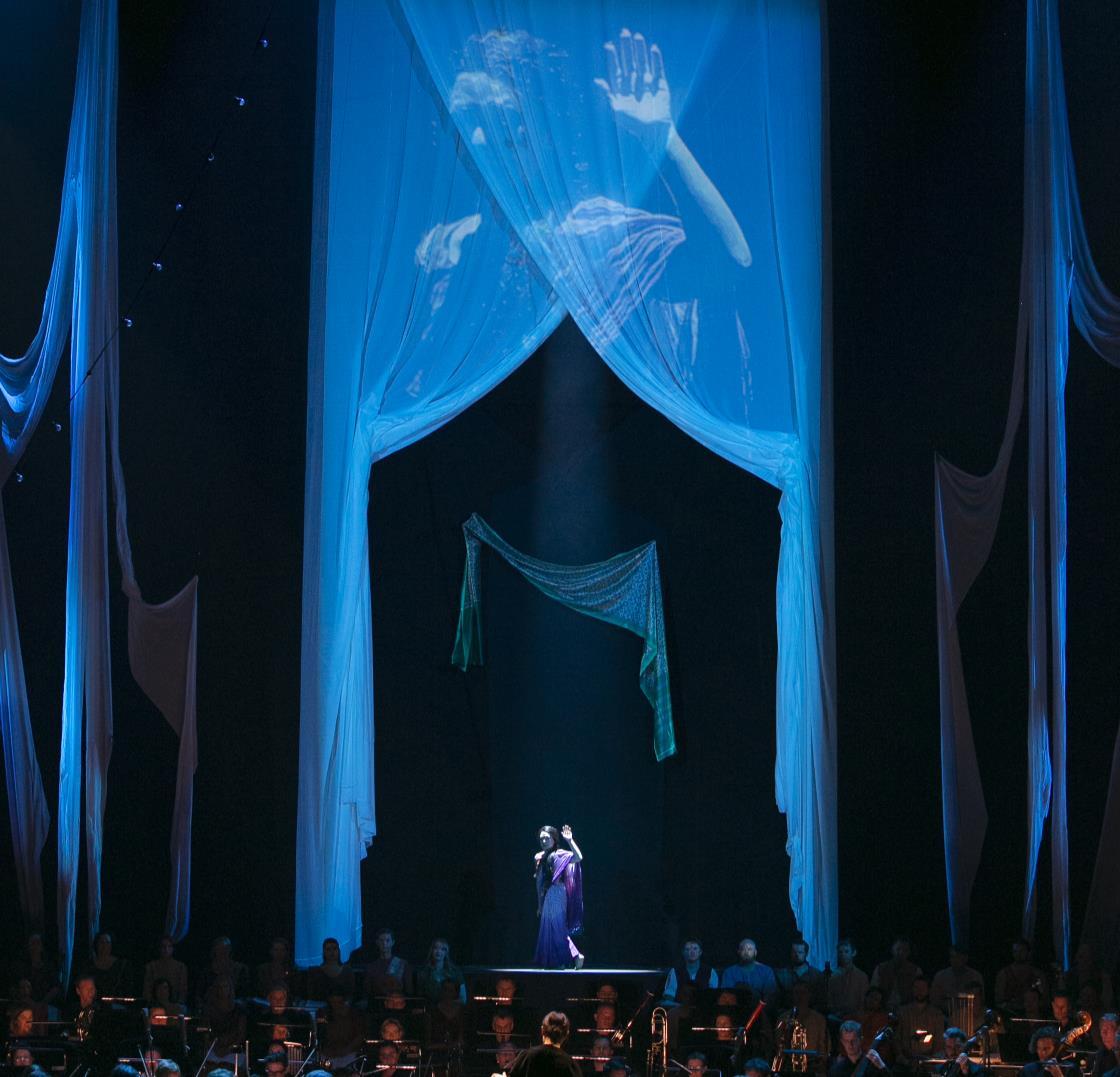
‘A third mainstage means we can explore ideas and repertoire that would not be possible otherwise. [Opera Queensland] needs the capacity to foster newer work and artists from different backgrounds.”
Umberto Clerici also noted that it is importantfor artistic companies to includeolder classics complemented by contemporary pieces, not only to educate the audiences but to build demand for the opera and igniteinnovation for new productions.
“When you put a new product in the productive world as marketing strategy – you put it between two really well-known products – this is how people accept the new and it becomes a classic. Why we do opera and why we need three staged operas is that we need to educate the audience/community with the achievements of the past. I don’t believe there is any invention without a reinvention of the past; nothing in a way is really new.”
That is, Opera Queensland’s portfolio should includewell-known pieces as well as contemporary works and three mainstageproductions enables a variety of different programming.


As a destination to visit, Brisbane, and Queensland more broadly, arewell-recognised for outdoor adventures, food and beverage, and the local culture.They are not well-recognised in terms of arts and culture.
The Ipsos Lifein Australia 2022 reportinvestigated the liveability across metropolitan Australia.Each capital city was rated on a scalebetween 0 and 10 across 16 liveability attributes. For the category ‘Museums, galleries & festivals’, Brisbane was ranked second last, relativeto other capital cities, with a scoreof 5.5, in front of Hobart which scored 5.4.
Additionally, the Anholt-Ipsos City Brands Index comparing perceptions of 50 cities globally –found that whileBrisbane ranked in the middleoverall, it ranked poorly on ‘Understand culture’. Furthermore, Brisbanewas ranked lower for contemporary arts and night life.
Clearly, there is an opportunity to help strengthen Brisbane’s brand as a creativeand cultural destination.Investment in Opera Queensland, for example through a third mainstage, could enablethe company to reach new audiences yet to be exposed to opera as an artform.
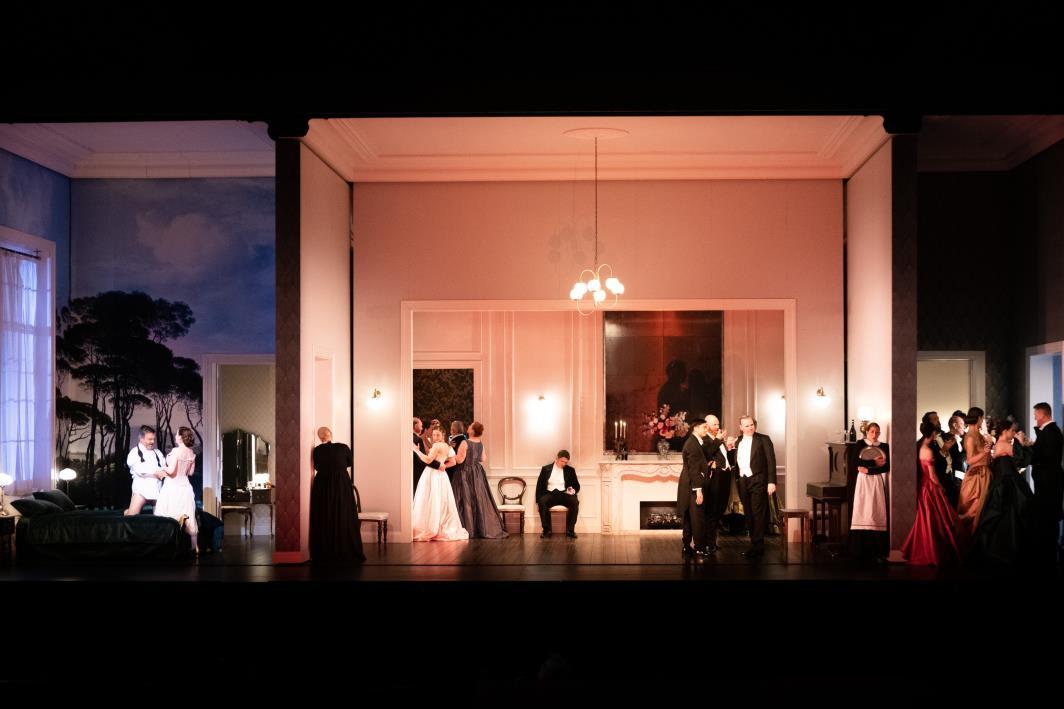
As a major report Performing Arts Advocacy in Australia (2021) by Prof John Daley showed, the Australian funding and political focus on sportis misplaced becauseAustralians aremorelikely to both watch and participatein the arts.
Australia’s public culture is overwhelmingly about sport, perhaps because a few events draw very big crowds. But the private lives of Australians are much more about arts and culture. More Australians buy tickets more often for performing arts performances than live sport, they watch twice as much drama as sport on television, and they are more likely to create arts and culture for themselves than to play sport.
Opera’s central place in the artistic realm means it provides a great starting point for turning that mismatch around Opera Queensland is atthe core of Queensland’s arts sector, one of the core creative arts organisations alongside Queensland Ballet, Queensland Symphony Orchestra, Circa,Dancenorth and Queensland Theatre.
Queensland is not known for culture—butperhaps it should be

In 2032 Brisbanewill hostthe Summer Olympic and Paralympic Games. This presents an opportunity to showcasethe best of what the city has to offer and convincevisitors thatBrisbaneis a destination with a strong tourismoffering.
Capitalising on Queensland’s investment in the Olympics and Paralympic Games
In the June 2022 Queensland Government budget $190 million was committed over four years to infrastructureplanning and development in preparation for the Olympic and Paralympic Games.17 A further $100 million will beallocated to build high-performancesports infrastructurein schools.18
The Olympic and Paralympic Games often attract significantnumbers of visitors internationally, interstate and intrastateto the hostcity. There is an opportunity to investin attractions to provide tourists with a variety of opportunities to experience Queensland’s culture.
In addition to building thecultural proposition of Queensland to showcaseto visitors, the IOC requires the production of a Cultural Olympiad in thehostcity. This event is a major festival of arts and culturewhich occurs in the four years leading up to the Games.
However, to build cultural tourism,investment in the arts, artists and arts workers leading up to the event will berequired to ensure a portfolio of high calibreperformances. Additionally, such skills requiretime to develop. KatieMcNamara from Opera Queensland noted the necessity for preparation for the Brisbane 2032 Games:
“Developing the skillset is not something that can be switched on in 2032.These skills need time to master.”
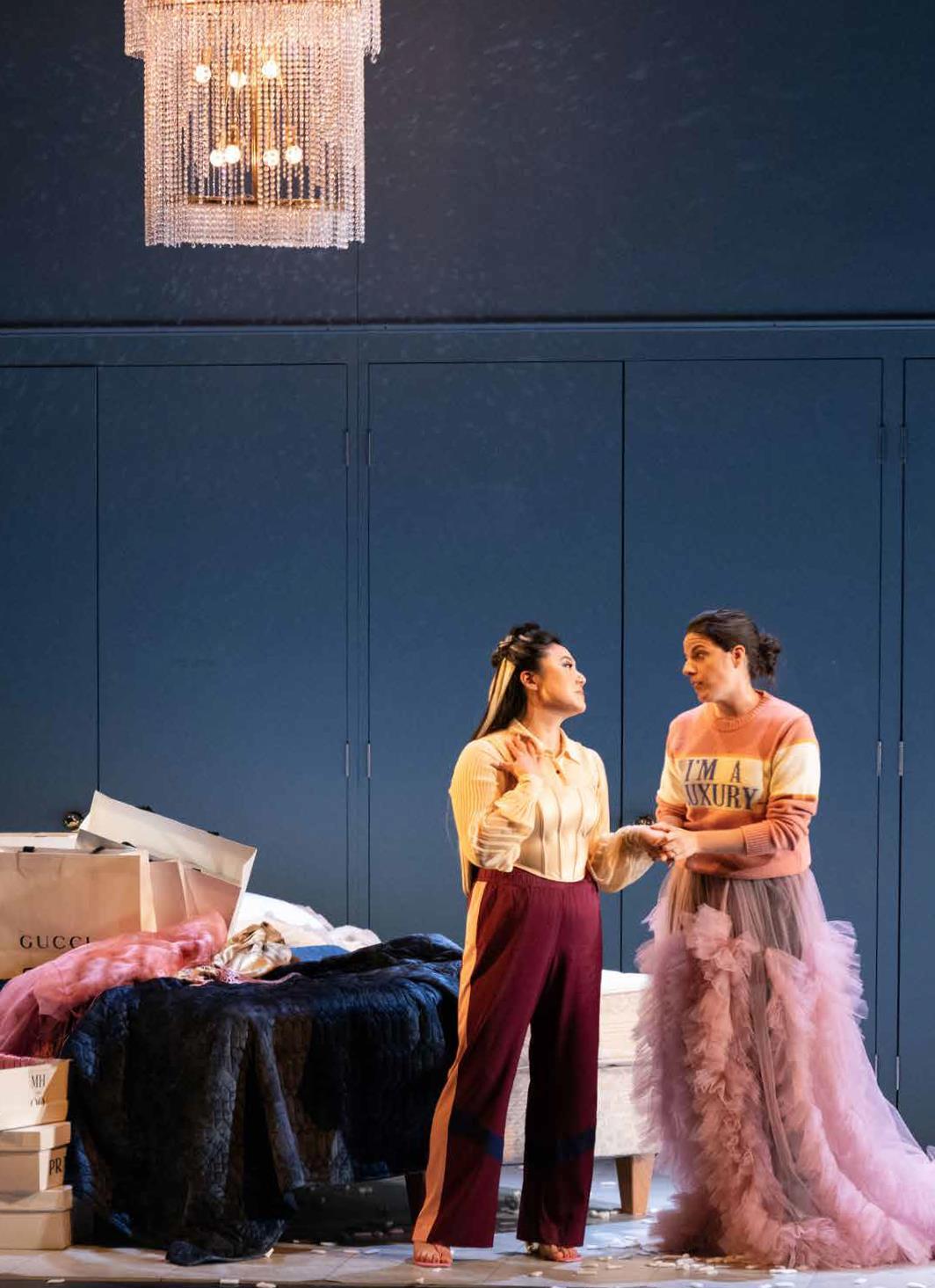
The upcoming 2032 Olympic and Paralympic Games provide a unique opportunityto improve the depth of the Queensland brand
Every successful Olympicand ParalympicGames City in the forty-year lead up to Brisbane2032 has been a major opera city too. In each host city, the local opera company annually performed at leastthree mainstageproductions except Rio, which was not viewed as a success.The 2032 Games is a cultural event, presenting an opportunity to showcasea city as more than sports and stadiums. Itrequires a dual investment in the arts and sports.
Queensland Symphony Orchestra’s Umberto Clerici has noted:
“Every single place where the Olympics were held – they showed their achievements in a way of culture… The thing that we need to put Brisbane on the map is creativity. Creativity also has to develop through the classical arts and not just with purely popular/commercial contemporary shows.”

Brisbanecan leveragethe profileof the Games and make the most of being on the world stage to be deliberateabout the image of the city that is being presented.
The Cultural Olympiad provides thevehiclefor this rebranding and a strong and vibrantlocal opera with a sustainablepresence in the market could be a key contributor to it. As key partners presented for this report indicate, opera skills arecomplex and sophisticated and take time to build. Should Queensland wish to broaden its brand ahead of the once in a generation opportunity of Brisbane2032, Opera Queensland is well placed to make a key contribution.
Table 3 highlights the number of mainstages an Olympic and Paralympic city’s local opera company produces annually.Exceptfor Rio, each city that hosted the Games has a local opera company that presents at leastthree mainstageproductions annually.The tablereinforces the notion that the 2032 BrisbaneGames is an opportunity to showcasethe city, not only by investing in sports butalso in its cultural landscape.In addition, itillustrates thathaving a vibrantopera company is integral to being a world city.
Summer Games hosts show that sporting cities can also be great opera cities
1. Opera Queensland, Annual Report 2021 (2021).
2. Australia Bureau of Statistics, Australian Industry 2019-20 (28 May 2021)
3. Deloitte Access Economics, Green investment: the social, cultural, and economic contribution of the Royal Botanic Gardens and Domain Trust (2022)
<https://www2.deloitte.com/au/en/pages/economics/articles/economic-social-cultural-contributionroyal-botanic-gardens.html>
4. Australia Council, Creating Our Future: Results of the National Arts Participation Survey (August 2020) <https://australiacouncil.gov.au/advocacy-and-research/creating-our-future/>
5. O'Neill, S., Edelman, J., Sloboda, J., Opera Audiences and Cultural Value:A Study of Audience Experience. (2014).
6. Ibid.
7. Opera Queensland, Annual Report 2021 (2021).
8. Taylor, P., Davies, L., Wells, P., Gilbertson, J., Tayleur, W., A review of the Social Impacts of Culture and Sport (2015)
<https://assets.publishing.service.gov.uk/government/uploads/system/uploads/attachment_data/fil e/416279/A_review_of_the_Social_Impacts_of_Culture_and_Sport.pdf>.
9. Cuypers, K., Krokstad, S., Holmen, T.L., Knudtsen, M.S., Bygren, L.O., Holmen, J., Patterns of receptive and creative cultural activities and their association with perceived health, anxiety, depression and satisfaction with lifeamong adults:the HUNT study, Norway Journal of Epidemiology & Community Health (2011).
10. Fielding, K., Glisic, I. and Trembath, J.-L., Transformative:impacts of cultureand creativity. A New Approach (2019) <https://www.humanities.org.au/new-approach/report2/>.
11. ‘A Brief History of Opera’ <https://www.operanorth.co.uk/explore-opera/a-brief-history-of-opera/>.
12. Opera Queensland, Annual Report 2021 (2021).
13. Opera Queensland provided data (November 2022).
14. Opera Queensland, Annual Report 2021 (2021).
15. ‘Wide-scalejob cancellations and nearly $50min lostincome’ (16 March 2020)
<https://ilostmygig.net.au/latest-news/f/wide-scale-job-cancellations-and-nearly-50m-in-lostincome>.
16. Australian Bureau of Statistics, Labour Force, Australia (September 2020).
17: Queensland Government, Brisbane2032 planning and investmentunderway (21 June 2022)
<https://statements.qld.gov.au/statements/95465#:~:text=Queensland's%20preparation%20for%20the% 20Brisbane,strategy%20to%20improve%20sports%20performance>
18: Ibid.



Value added is the most appropriate measure of an industry’s/company’s economic contribution to gross domestic product (GDP)at the nationallevel, or gross state product (GSP) at the state level. Other measures, such as total revenue or gross output, maybe easier to estimate than value added but they ‘double count’. That is, they overstate the contribution ofa companyto economic activitybecause theyinclude, for example, the value added byexternal firms supplyinginputs or the value added byother industries.
The economic activityaccountingframework is presented in Figure A1, showinghowtotal revenue can be disaggregated into component parts in order to measure the economic contribution ofan entityor industry. The framework demonstrates the definition of value added being the difference between total revenue and intermediate inputs.
When calculating the grossoperatingsurplus (GOS)for a typical for-profit firm or industry, income streams from government (such as transfers or production subsidies)are excluded as they are a transfer of public funds, not reflective of income generated bythe activities ofthe firmor industry. However, for non-profit organisations providinga service that generatesexternal, non-use benefits that are not reflected in market prices, government transfers are included in the GOS calculation as theyare fundamental to ongoing operations. Similarly, value added is typicallycalculated as GOSplus labour income net of subsidies.
The direct economic contribution is a representation ofthe flowfrom labour and capital within the sector of the economyin question.
The indirect contribution is a measure of the demand for goods and servicesproduced in other sectors as a result of demand generated bythe sector in question. Estimation ofthe indirect economic contribution is undertaken in an input-output (IO) framework using Australian Bureau of Statistics input-output tables which report the inputs and outputs of specific sectors of the economy(ABS 2022).
IO tables are required to account for the intermediate flows between sectors. These tables measure the direct economic activityof everysector in the economyat the nationallevel. Importantly, these tables allowintermediate inputs to be further broken down bysource. These detailed intermediate flows can be used to derive the total change in economic activityfor a given sector.
A widelyused measure ofthe spill over of activityfrom one sector to another is captured bythe ratio of the total to direct change in economic activity. The resultingestimate is typicallyreferred to as ‘the multiplier’. A multiplier greater than one implies some indirect activity, with higher multipliers indicatingrelativelylarger indirect and total activityflowing from a given level ofdirect activity.
The total economic contribution to the economyis the sum ofthe direct and indirect economic contributions.
Source: DeloitteAccess Economics
In a fundamental sense, economiccontributionstudies aresimply historicalaccounting exercises.The analysis— as discussed inthereport— relies on a national input-outputtablemodelling framework and there aresomelimitations to this modelling framework. Theanalysis assumes thatgoods and services provided to the sector areproduced by factors of production thatarelocated completely within thestateor region defined and thatincomeflows do notleak to other states.
The IO framework and thederivation of themultipliers also assumethattherelevanteconomic activity takes placewithin anunconstrained environment. Thatis, anincreasein economicactivity inonearea of the economy does notincreaseprices andsubsequentlycrowd outeconomic activity in another area of the economy. As a result, themodelled total and indirectcontributioncanberegarded as an upper-bound estimateof the contributionmadeby thesupply of intermediateinputs.
Similarly theIO framework does notaccountfor further flow-on benefits as captured ina moredynamic modelling environmentlikea ComputableGeneral Equilibriummodel.

Economic contribution studies are intended to quantify measures such as valueadded, exports, imports and employment associated with a given industry or firm, in a historical reference year. The economic contribution is a measure of the economic value of production by a firm or industry
This analysis uses theTSA approach to measuring the economic contribution of attributabletourism. The TSA framework is conceptually similar to and draws on the ABS IO tables to generate results.Itis based on an international approach to defining the tourismsector and different tourismproducts and related industries depending on the extent to which they interactwith tourists either directly or indirectly.
Conventional IO modelling can be applied to any sector of the economy (including tourismby using an appropriatesector-specific definition of the tourismsector). However, the TSA approach is DeloitteAccess Economics’ preferred approach to measuring the economic contribution of the tourismsector as it ensures that the analysis is consistentwith international guidelines for measuring and reporting on the economic activity of the tourismsector.
A directcontribution occurs where there is a directrelationship, both physical and economic, between the visitor and the producer of the good or service.Direct tourismoutput is essentially theamount of tourismconsumption less net product taxes, wholesaleand transportmargins and imports.
In the caseof retail goods purchased by visitors, only theretail margin contributes to direct tourism output, valueadded and Gross Regional Product.This is becauseitis deemed that only the retailer has a directrelationship with the visitor and is therefore partof the tourismindustry.As a consequence the output, and consequently valueadded, attributed to other (than retail) industries is excluded from the valueof directtourismoutput. Directtourismoutput is therefore equal to internal tourismconsumption at basic prices less thecost to retailers of domestic goods sold directly to visitors.
Direct tourismgross valueadded shows only the 'value' which a producer adds to the raw material goods and services itpurchases in the process of producing its own output. Direct tourismgross valueadded is measured as the valueof the output of tourismproducts by industries in a directrelationship with visitors less the valueof the inputs used in producing these tourismproducts.
The indirecteffect of tourismconsumption is a broad notion that covers upstream and supplier effects of tourismdemand. Intermediate inputs represent those goods and services which supportthe supply of the tourismproduct – the cleaning services thatareinputted to the hotel sector; the fuel that is inputted to the aviation industry;the fruitand vegetables that are inputted to the restaurantindustry. Together with any upstream impacts, itis these flow-on effects which determine the tourismindustry’s indirect contribution.
The definition of direct and indirectareslightly differentin the TSA approach as directis defined as activity involving a directinteraction with tourists. Accordingly, theratio of directand indirectactivity differs from results using a standard IO approach.However, estimates of total valueadded and employment should be similar across thetwo approaches.
The modelling for attributed visitor expendituremakes the following key assumptions:
• Due to data limitations, thereis no data which clearly defines whether opera was the primary reason for visiting Queensland. Consequently, tourismbenefits generated through Opera Queensland’s productions arebased upon attributableactivity rather than induced activity.
• It is assumed that, without Opera Queensland’s productions, theattributed visitor expenditurewould otherwise be spent in a different country or state, and therefore would not otherwise contribute to the Queensland economy.

This analysis excludes any tourismbenefits associated with Brisbane-based opera attendees. This is for two key reasons:firstly, they arenot considered tourists by the standard definition fromTourism Research Australia and, secondly, itis much more difficultto be confident their expenditure in the State is directly attributableto the opera, or whether they may have been likely to spend their money within Queensland, in some other way.
Tourism contribution studies are intended to quantify economic benefit measures such as valueadded and employment that results from tourism consumption
Limitation of use
General use restriction
This reporthas been preparedsolely for the use of Opera Queensland, for the purpose of summarising the economic andsocial benefits attributable to a permanentthirdmainstage production. This report is not intendedto and shouldnotbe used or relied upon by anyone else and we acceptno duty of care to any other personor entity.You should notrefer toor use our name orthe advice for any other purpose.
Deloitte Access Economics is Australia’s pre-eminenteconomics advisory practice and a member of Deloitte's global economics group. Formore information, please visitourwebsite: www.deloitte.com/au/deloitte-access-economics
This publication contains general information only, and none of Deloitte Touche Tohmatsu Limited,its memberfirms,or their related entities (collectivelythe “Deloitte Network”) is, by means of this publication, rendering professionaladvice orservices. Before making any decision ortaking any action that may affectyour finances or your business, you shouldconsulta qualifiedprofessional adviser. No entityin the Deloitte Network shall be responsible for any loss whatsoeversustainedby any person who relies on this publication.
Deloitte refers to one or more of Deloitte Touche Tohmatsu Limited (“DTTL”),its global networkof member firms,and their related entities. DTTL (also referred to as “Deloitte Global”) and each of its member firms andtheiraffiliated entities are legally separate andindependent entities. DTTL does notprovide services to clients.Please see www.deloitte.com/about tolearn more.
About Deloitte
Deloitte is a leading global provider of audit and assurance, consulting, financial advisory, risk advisory, taxandrelated services.Our network of memberfirms inmore than 150countries and territories serves four outof five Fortune Global 500®companies.Learn howDeloitte’s approximately 286,000 people make ani mpact that matters at www.deloitte.com.
About Deloitte Asia Pacific
Deloitte Asia PacificLimitedis a company limited by guarantee anda memberfirm of DTTL.Members of Deloitte Asia Pacific Limitedandtheirrelated entities provide services in Australia, Brunei Darussalam,Cambodia,East Timor, Federated States of Micronesia,Guam,Indonesia, Japan, Laos,Malaysia, Mongolia,Myanmar, New Zealand,Palau,Papua New Guinea, Singapore,Thailand, The Marshall Islands, The Northern Mariana Islands, The People’s Republicof China (incl. Hong Kong SAR andMacauSAR), The Philippines and Vietnam,in each of which operations are conducted by separate and independentlegal entities.
About DeloitteAustralia
In Australia, the Deloitte Network member is the Australianpartnershipof Deloitte Touche Tohmatsu. As one of Australia’s leading professional services firms.Deloitte Touche Tohmatsu andits affiliates provide audit, tax, consulting, and financial advisory services through approximately 8,000people across the country. Focused on the creation of value and growth, and known as an employerof choice for innovative humanresources programs,we are dedicated tohelping ourclients and our people excel. For more information, please visit ourwebsite at www.deloitte.com.au
Liability limitedby a scheme approved under Professional Standards Legislation.
Member of Deloitte Asia Pacific Limited andthe Deloitte Network.
© 2022 Deloitte Touche Tohmatsu. CoRe Creative Services. RITM1242412